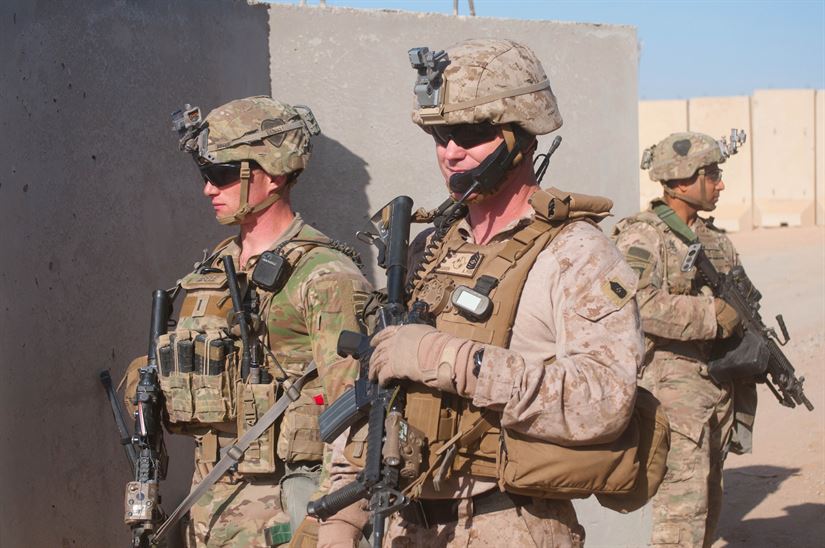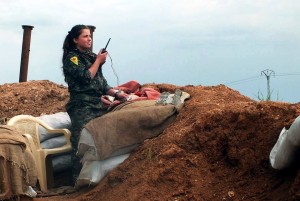By Nick Turse
They called it Castle Black, an obvious homage to the famed frozen citadel from the HBO series Game of Thrones. In the fantasy world of GoT, it’s the stronghold of the Night’s Watch, the French Foreign Legion-esque guardians of the northern border of the Seven Kingdoms.
This Castle Black, however, was all too real and occupied by U.S. Special Operations forces, America’s most elite troops. In its location, at least, it was nearly as remote as its namesake, even if in far warmer climes — not on the northern fringe of Westeros but at the far edge of eastern Syria.
Today, the real Castle Black and most of the archipelago of U.S. outposts only recently arrayed across the Syrian frontier are emptying out, sit abandoned, or are occupied by Russian and Syrian troops. At least one — located at the Lafarge Cement Factory — lies in partial ruins after two U.S. Air Force F-15 jets conducted an airstrike on it. The purpose, according to Colonel Myles Caggins, a spokesman for Combined Joint Task Force-Operation Inherent Resolve (CJTF-OIR), the U.S.-led military coalition fighting ISIS, was to “destroy an ammunition cache, and reduce the facility’s military usefulness.”
“Only yesterday they were here and now we are here,” a Russian journalist announced after taking selfies at the abandoned base at Manbij where U.S. forces had served since 2015 alongside allied Syrian Democratic Forces (SDF), a coalition of mainly Kurdish and Arab fighters. “It appears as though the U.S. servicemen fled in their armored vehicles,” said another reporter with RT’s Arabic service, as she walked in front of American tents and equipment at the hastily abandoned outpost. Photographs show that when U.S. troops bugged out, they also left behind other standard stuff from American bases abroad: “crude dick drawings,” a football, fridges stocked with Coca-Cola, an open package of animal crackers, a can of Pringles, and a paperback copy of The Girl With The Dragon Tattoo.
“I see a big problem with it. And it shows just how unplanned and half-assed this ‘withdrawal’ is,” U.S. Marine veteran Anderson Bryant, who — in 2016 — fought alongside the SDF after leaving the Corps, told Military Times. “Though ISIS doesn’t have the infrastructure to take and hold territory or bases anymore, just leaving equipment to be taken after a retreat looks bad for sure.”
Bryant was just one of many to decry the abandonment of most of Washington’s Syrian outposts. “U.S. troops and their allies feel humiliated after abandoning their bases in Syria to be taken over by gleeful Russians,” read the headline of a Business Insider article, while a New York Times piece put it this way: “Pullback Leaves Green Berets Feeling ‘Ashamed,’ and Kurdish Allies Describing ‘Betrayal.’”
A Base by Any Other Name…
After President Trump abruptly ordered the withdrawal of most U.S. forces from Syria earlier this month, a Turkish military incursion into the area those troops had previously occupied set off a humanitarian catastrophe — sending nearly 200,000 civilians fleeing from the Syrian frontier, about one third of them children. President Trump implied the troops were coming “back home,” but his secretary of defense promptly contradicted him and indicated they would simply be redeployed in the region. After being abandoned by their U.S. allies, the SDF struck a deal with Syrian dictator Bashar al-Assad and Syrian and allied Russian troops moved into the area as well. In the chaos, some Islamic State prisoners escaped from SDF prisons.
Back in the United States, rare bipartisan outrage erupted as members of Congress lambasted the president for his decision. Vice President Mike Pence was then dispatched to Turkey to try to mitigate what was widely hailed by the Washington establishment as a foreign policy disaster. Then, in the wake of a Pence-negotiated “ceasefire” that Turkey didn’t agree to and that failed to fully materialize, President Trump took a victory lap after which Turkish President Recep Tayyip Erdogan vowed to “crush” the heads of America’s abandoned Kurdish allies if they didn’t ethnically cleanse themselves from the area. In the end, the withdrawal of 1,000 U.S. military personnel turned out to be largely illusory, as an influx of new forces to a different part of Syria left troop levels almost unchanged.
In the midst of this chaos, however, something strange occurred. Just as America’s Syrian bases, including its two main headquarters — Advanced Operational Base West and Advanced Operational Base East — the Lafarge Cement Factory, and a facility at Manbij were being abandoned, in another sense entirely they suddenly came to exist (at least in news reports anyway). This is something that Castle Black, in its relatively brief life, never officially did. When I asked about its status in late August, for example, Combined Joint Task Force-Operation Inherent Resolve refused to even acknowledge the existence of such a base. Now, the outpost and its status are no secret at all. “Castle Black is closed,” CJTF-OIR’s media team told TomDispatch more recently.
According to the Pentagon’s official inventory of bases, the Department of Defense (DoD) “manages a worldwide real property portfolio” that spans 45 foreign countries. All told, there are 514 official “DoD sites” overseas, the majority of them in Germany (194 sites), Japan (121 sites), and South Korea (83 sites). This list, however, has never included mention of even one base in Syria — or, for that matter, any of the well-known U.S. garrisons, large and small, in Afghanistan or Iraq.
The common estimate of foreign U.S. military bases is actually around 800. Such a count is little more than an educated guess because of the cloak of secrecy the Pentagon has thrown over the subject. To obfuscate things further, the military employs a plethora of euphemisms to avoid calling U.S. military outposts like Castle Black precisely what they are.
Officially, Castle Black was never a base. It was, instead, a “Mission Support Site” or MSS. And while U.S. Central Command (CENTCOM), which oversees United States military operations in the Middle East, acknowledges the existence of MSSes, it won’t provide even a basic count of them, let alone more detailed information about such outposts, significant numbers of which exist across the region. The media operations staff of CJTF-OIR responded in an email to a TomDispatch request on the subject this way: “Due to operational security reasons, a total number and locations of the various mission support sites are not available.”
And keep in mind that such Military Support Sites only begin to scratch the surface when it comes to the Pentagon’s inventory of non-base outposts. So when else is a military base not a military base? When, for example, it’s an Initial Contingency Location, which, according to a Pentagon “Contingency Basing” manual, is characterized by austere infrastructure and limited services. Or when it’s a Temporary Contingency Location, which provides “near-term support for a contingency operation” and is characterized by “expedient infrastructure.” Or even when it’s a Semipermanent Contingency Location, which provides support for prolonged contingency operations and is characterized by “enhanced infrastructure.” Or when it’s a full-fledged Contingency Location — a “non-enduring location outside of the United States that supports and sustains operations during contingencies or other operations.”
Such U.S. non-bases also include Forward Operating Sites (FOSes), which are officially defined as “scalable” locations intended for “rotational use by operating forces.” While “rotational use” might make such a place sound like a distinctly temporary location, possibly one abandoned for long stretches, that’s hardly the case. Camp Lemonnier in the sun-bleached Horn-of-Africa nation of Djibouti, for example, is not only an FOS, but also America’s largest base on the African continent and the headquarters for Combined Joint Task Force-Horn of Africa (CJTF-HOA), which includes soldiers, sailors, and airmen, some of them members of the Special Operations forces. The camp — which also supports CENTCOM — couldn’t be less temporary, having expanded from 88 acres to 600 acres, while the number of troops stationed there has jumped by more than 500%, to 5,500, since 2002.
Another type of outpost is a cooperative security location, or CSL, which is supposedly neither “a U.S. facility or base.” According to the Pentagon’s official definition, it has “little or no permanent United States presence” and “is maintained by periodic Service, contractor, or host nation support.” This, too, is completely disingenuous. A CSL in the remote smuggling hub of Agadez, Niger, for example, is the premier U.S. military outpost in West Africa. That drone non-base, located at Nigerien Air Base 201, not only boasts a $100 million-plus construction price tag but, with operating expenses, is expected to cost U.S. taxpayers more than a quarter of a billion dollars by 2024 when the 10-year agreement for its use ends.
The primary types of places that the Pentagon will actually call “bases” are huge World War II and Cold War legacy sites like Ramstein Air Base in Germany, Kadena Air Base in Okinawa, Japan, and Camp Humphreys in South Korea. These they call “Main Operating Bases.” Humphreys, for example, began its existence in 1919 as Pyeongtaek Airfield, a product of the brutal Japanese occupation of Korea. Since the Korean War (1950-1953), the U.S. military has occupied the site, transforming it into America’s largest overseas military base. The Pentagon refers to Forward Operating Sites, Cooperative Security Locations, and Main Operating Bases as “enduring locations” which are meant to afford “strategic access” to American forces and support Washington’s security interests for the “foreseeable future.”
Despite these and other euphemisms for bases that appear in the Defense Department’s 2019 edition of Joint Publication 4-04 “Contingency Basing” and its most recent “Base Structure Report,” many other types of smaller baselets get scant attention — including Combat Outposts and Fire Support Bases. Even more types are noted in various official publications and military news releases, often with conflicting definitions. The Army’s Ranger Handbook, for instance, defines a “patrol base” as a “security perimeter” set up when a squad or platoon is “conducting a patrol,” but notes that it should “not be occupied for more than a 24-hour period (except in an emergency).” An Army counterinsurgency manual, on the other hand, states that a “patrol base can be permanent or temporary.” And a 2008 CENTCOM news release mentioned that soldiers with the 2nd Battalion, 502nd Infantry Regiment had been stationed at Iraq’s Patrol Base Copper for seven months.
While Mission Support Sites are mentioned in a few Pentagon publications, they are also poorly defined. When asked just what an MSS actually is, an official at CENTCOM offered this none-too-illuminating response: “Mission support sites, or bases, are sites that temporarily exist to provide support for as long as a mission requires.” That same official went on to note that the U.S. and its allies had “opened and closed numerous bases throughout the campaign in Syria and Iraq,” but refused to provide details or even a simple count of how many bases had been closed, let alone opened. The CJTF-OIR media team was a bit more forthcoming, explaining that a mission support site is “comparable to an initial contingency location (ICL) or a patrol base” and that such facilities support up to 200 personnel for a “total duration of operations lasting less than six months.”
Winter Is Coming for U.S. Military
Castle Black is now officially shuttered. Despite its closing and that of its sister outposts, as part of Donald Trump’s “withdrawal” from Syria, American troops remain in that country. “CJTF-OIR continues to maintain a presence in Syria and Iraq as part of our mission to achieve the enduring defeat of Daesh,” spokesperson Col. Myles Caggins III told TomDispatch, using the Arabic acronym for ISIS.
Commander Sean Robertson, a Pentagon spokesperson, was even more specific. “U.S. forces continue a deliberate, phased, and orderly withdrawal from Syria, with the exception of the al-Tanf garrison,” he told TomDispatch. While Robertson refused to “discuss operational details such as numbers or timelines,” it has been widely reported that al-Tanf, a small base in the south of Syria, is still home to about 150 U.S. forces. (It, in turn, is supported from across the Jordanian border by a quick reaction force, additional troops, and artillery.) The CJTF-OIR media team also added that the “Kobani Landing Zone and other sites remain open to facilitate the additional movement of troops and equipment outside of Syria.” Reports now indicate that U.S. troop levels will stabilize at around 900, just 100 troops less than before the announced withdrawal.
The abandonment of about a dozen outposts across northeastern Syria likely constitutes the largest mass closure of military bases of the Trump presidency. (Since the Pentagon refuses to provide an accurate count of overseas outposts, however, there’s no way to make certain of that.) Still, while this reduction of outposts in Syria is significant, it hardly constitutes a substantial drawdown of U.S. forces in the region (especially at a moment when President Trump may be sending tanks and armored vehicles, with all the necessary supporting forces, into the area around Syria’s oil fields). With the president either reshuffling troops in Syria or merely relocating them elsewhere in the Middle East and a new contingent of American forces deploying to Saudi Arabia, there will actually be a net gain in U.S. troops in the region at this moment of supposed reduction.
Perhaps the only true end result of the drawdown in Syria — given that the finale of Game of Thrones ran earlier this year — is the likely demise of U.S. military outposts named for that HBO show’s fictional redoubts. With the real Castle Black gone and the fictional one consigned to the dustbin of pay-for-play streaming services, tomorrow’s bases will undoubtedly be named for emerging cultural touchstones, not last season’s leavings.
Still, given Washington’s penchant for Middle Eastern military missions, the likelihood of yet more U.S. bases across the region (whatever their official designations), and talk of several Game of Thrones prequels still to come, there may be ample opportunities for the next set of off-the-books military bases to carry the names of even more ancient Seven Kingdoms castles, keeps, and citadels.
Nick Turse is the managing editor of TomDispatch and a fellow at the Type Media Center. He is the author of Next Time They’ll Come to Count the Dead: War and Survival in South Sudan.
Follow TomDispatch on Twitter and join us on Facebook. Check out the newest Dispatch Books, John Feffer’s new dystopian novel (the second in the Splinterlands series) Frostlands, Beverly Gologorsky’s novel Every Body Has a Story, and Tom Engelhardt’s A Nation Unmade by War, as well as Alfred McCoy’s In the Shadows of the American Century: The Rise and Decline of U.S. Global Power and John Dower’s The Violent American Century: War and Terror Since World War II. Published with permission from TomDisptach.





